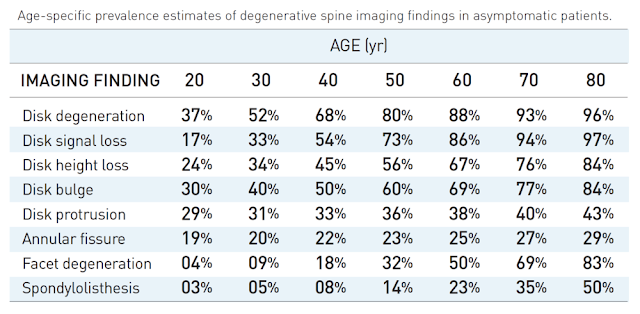If you have ever been to a doctor’s
office and had an x-ray performed, you have likely heard about something called
spinal degeneration. Spinal degeneration is a condition in which the discs and
joints of the spine begin to narrow and often form bone spurs.
If you’ve ever been to a
chiropractor’s office and seen your x-rays, you’ve probably seen a chart that
looks like this:
You compared yourself to one of
these images, and identified yourself within one of the various phases of
spinal degeneration. Maybe you felt confused. Maybe you felt alarmed, perhaps
even a little scared. Either way, you knew that your spine probably didn’t look
like the “normal” and that you had work to do.
How
Bad is it Really?
No one likes to be told that their
spine is developing arthritic degeneration. It’s a sign that the days of our
youth are fading, and a reminder that our bodies are not going to last forever.
Everyone will develop some level of
spinal degeneration as we get older.
Regardless of whether someone has a
lifetime of chiropractic, supplements, positive mental attitude, etc, we cannot
stop discs from breaking down or bone spurs from forming. Once people get
into their 40’s and 50’s, we expect to see some degree of degeneration in the
spine to occur.
Are there those in their 70’s
without it? Sure. But those are OUTLIERS, and we don’t make predictions based
on a handful of outliers.
With that being said, here are some
quick facts to know about spinal degeneration.
1. Degeneration ≠ Pain –
One of the things that frustrates me is when someone tells a patient that they
are going to live with chronic pain because they have spinal degeneration.
While many people with degeneration
do have spinal pain, an OVERWHELMING MAJORITY of people with degeneration have
no pain what so ever.
While a lot of people with pain have
some level of spinal degeneration, that doesn’t mean that spinal degeneration
is the CAUSE of their pain.
I’ve seen many patients with massive
spinal degeneration, and many of them will get better despite the fact that
their degeneration has NOT CHANGED.
We have to resist being trapped
within a diagnosis, especially if that diagnosis has a high degree of
inaccuracy.
2. Your Spine Isn’t Going to Fuse
(Probably) – some patients have concerns that a doctor told them that
their spine is fusing. This is always something that raises my eyebrows because
there are less than a handful of situations where you would expect the segments
of the spine to fuse together.
- Vertebra don’t fuse as they degenerate. Discs will get closer together to where there’s minimal space, but regular degeneration WILL NOT turn into a fused vertebra. They are completely different things.
- We have NO idea what the time table is on degeneration.
Except in cases of certain disease
processes (i.e. – ankylosing spondylitis), this is nothing but fear mongering.
Degeneration,
not Death Sentence
Degeneration can be a problem for
some patients. Loss of hydration in the disc, and lack of movement in the spine
can create problems for the brain and nervous system.
Time and again, I’ve seen patients
who have been told that their problem is related to arthritic knees, hips,
and spines respond really nicely to Structural Correction. Even without seeing
any change to the degenerated joint.
If the arthritis were the sole
problem, then no one with spinal degeneration would ever get better.
Degeneration is a sign of a
breakdown process, but it’s not usually the cause. We need to be freed
from these self-defeating labels that hold us back from living the active and
healthy lifestyle we all deserve. If you’ve been told that your pain or problem
is because of arthritis or degeneration, it may be time to get another opinion.
Call our office today and book your
appointment to get back on the right track. 248-287-8700





